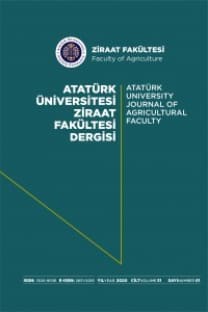ERZURUM ÎLt MERKEZ tî ÇEDE KAMU KURULUŞLARI DESTEĞİYLE YAPİLAN SÜT SIĞIRI AHIRLARININ YAPISAL DURUMU VE GELİŞTİRME OLANAKLARI ÜZERİNE BİR ARAŞTIRMA
ÖZET: Bu çalışma, Erzurum Merkez İlçede Kamu Kuruluşları desteğiyle yapılan sütsığın ahırlarının barınak içi çevre koşullarım ve ahtrlannyapısal durumlarını belirlemek,geliştirme olanaklarını saptamak., yörede uygulanabilecek ahır planlarını hazırlamak amacıylayapılmıştır. Araştırma amacını gerçekleştirebilmek için yöredeki 21 süt sığm ahin araştırmamateryali olarak alınmıştır.Araştırma ahırlarının 8'inde sıcaklık, bağıl nem ve havalatıdırma durumlarım belirlemekamacıyla ölçümler yapılmıştır. Araştırma sonucunda ahırların büyük çoğunluğunun uygunçevre koşullarım sağlayamadığı ve ahır planlamasında gerekli planlama ilkelerinin yeteri kadargöz önüne alınmadığı saptanmıştır. Araştırmadan elde edilen sonuçlar ve yöre koşullarıgözönünde tutularak yörede uygulanabilir nitelikte 10,20 ve 50 başlık duraklı (bağlı) süt sığırıahrpjankm bamkam$ar.A RESEARCH ON THE STRUCTURAL CONDİTİONS AND THEPOSSIBILTTIES FOR THE IMPROVEMENT OF THE DAİRY CATTLEBARNS CONSTRUCTED WITH THE AİDS OF STATE ORGANISATIONS AT CENTERAL DISTRICT IN ERZURUM PRO VİNCESUMMARYThe aim this study is to investigate the existing siructural conditionsand enviromental conditions, to explore the possibilities for the improvemetu of present structures and to design asuggestible plans for the dairy cattle barns at the Centreal District inErzurum province. în this study, 21 dairy cattle barns at this district vvere investigated andinside temperature and relative humidity, aİr velocity vvere measured at 8 of them. The dataabout these bams were obtained by the measurements, the shematic dravvings, the surveys andthe observations. For enviromental conditions, thermohygrographs recording weekly changesof the temperature and the relative humidity vvere uşed. The wind speed and air velocity in theopennings were measured with anemometer, Thefollovving results were obtained from thisstudy.In winter season the average temperatures in barns were between 6.6 - 205 oC. Thesetemperatures are in the proper range suggested by the workers in this field. The evaragerelative humidities are found between 78-90 %. These values are in the level which couldadversely ajfect the animal healt and yield. Therefore, relative humidity must be controlled byventilation and vapor insulation to keep the relative humidity in the safe limits must be used.The avarage heat conductivity values for the walls, the roofs or ceilings, the doors andwindows are determined. They are between 0,410-2,590 Kcalirrû, oCh, 0,405-0,915 Kcalirrû,oCh, 2, 780-5,100 Kcalirrû. oCh, and 4^00-6,000 KcaUm2 oCh respectively. These figuresare heigher than the values suggested for the shelters in the cold regions. So the heatinsulations of these barns have to be improved.For designing purposes, 7oC and l5oC temperatures and 80% relative humidity for theinside vvere selected. -12 J5 oC and 76% relative humidity for the outdoor vvere taken to makethe necessary ccUculations.The heat conductivity values should be betvveen 0,289-0,563 Kcal!m2 oCh for thewalls, 0,242-0,538 Kcallm2 oCh for the cailings if the inside temperature is 7oC. For theinside temperature loC these values are 0,224-0J98 Kcal!m2 oCh, and 0,184-0^64 KcaUm2oC respectively. At the inside temperature l5oC ali ofthe_$ensible heat generated by cows losesby ventilation.The air velocities in the ventilation outlets vvere measured and average ventilation ratesvvere calculated as 5,7-78,4 m3/h per 454 kg body vveight of cattle. The ventilation isinsufficient and moisture condensed in the barns because the outlets and vvindovvs are halfclosed during the vvinter and completely closed in the cold days. It iş determined that tomaintain a suitdble environment in the barns the ventilation rate in vvinter should be 85 m3f76 m3/h and 65 m3/h per 454 kg body weighîfor the inside temperature 7oC, lOoC and 15oCrespectively,The total area of the cutlets are between 0,04-1.80 m2 and the fresh air enters throughthe windows of the barns. The total area of the openings and the ratio between them are notproper. The area of the outlets should be between 027-1,16 m2 for 7oC, 022-0,93 m2 forlOoC and 0,17-0,74 m2 for 15oC in winter; for inlets these values should be 020-0,85 m2,0,16-0,68 rrû and 0,12-0,54 m2 respectively.In spring and autumn the ventilation rates should be between 207,7-232,5 m3/h per 454kg body weight. In these seasons the area of the outlets and inlets should be betvveen 1.19-5,19m2 and 0,89-3,88 m2 respectively.ifa mechanical ventilation is desired there is a need for four fans having changablespeeâs and capacities 850-3900 m3!h.The lighting is accomplished naturally and artifıcally. The ratio of the windows area tofloor area are between 2,0-6,5% and artifıcial lighting density are betvveen 021-226 W/m2.The ratio of the vvindovvs area to floor area in the dairy barns should be 3,5-4% for coldregions.The barns investigated are s tali barns and 9,5% of them are one row and 90,5% ofthem are two rows. The wide, long and high of the barns are between 420-8,40 m,9,70-28,60 m, and 2,50-425 m respectively. The inner volume is between 7,75-21,06 m3 per454 kg body vveight cattle.The dairy barns were built by the different materials. 66,7% of them were built bymasondry, 23,8% by bricks, 9J% bricks and cinder-concrete blocks. The floor is concrete inali of the barns. The interior side of the walls'has plaster in the 85,7% of the barns and theexterior side of the walls are plastered in the 66,7% of them, there is no plaster on the vvalls inthe 4,8% of them. The windows are single glass. İt is advisable that bricks. Cinder-concreteblock and light concrete block should be used and the windows should bu double glassed.The roofs of the barns are gable type in the 85,7% shed-type in the 14,3%. Corrugatedplates are used as a roofcovering material. The ridge height of the roofs are between 1,40-2,80m. 71,4% of the barns have a ceiling. It is advisable to build a ceiling to help heat balance.The dairy cattle stall barns plans for 10,20 and 50 cattle are preparedfor this region and given in the fıgures l, 2 and 3.
